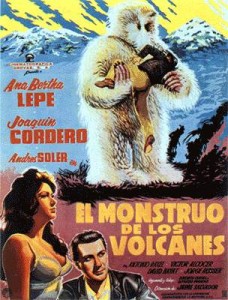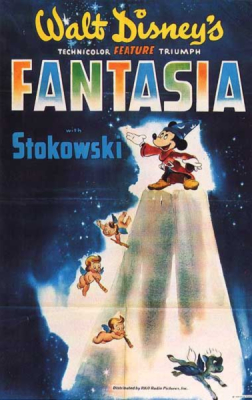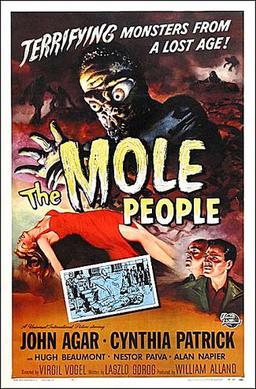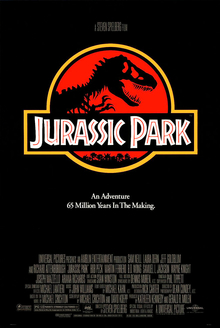Instead of candy, why not try some nutritious squash?
Sunday, October 31, 2010
Saturday, October 30, 2010
Geological Frightfest: The Monolith Monsters

Lee Allison at Arizona Geology deserves credit for inspiring the last movie in the Frightfest series - in his post from June about the Piranha 3D movie, he also mentioned The Monolith Monsters. Again, it's another 1950s movie I haven't had the chance to see, but I'll definitely have to remedy that if I can...guess what's next on the Netflix queue? With a title like that, though, I couldn't resist looking it up. And boy, this one is a doozy. Here's the IMDB summary:
A strange black meteor crashes near the town of San Angelo and litters the countryside with fragments. When a storm exposes these fragments to water, they grow into skyscraper-sized monoliths which then topple and shatter into thousands of pieces that grow into monoliths themselves and repeat the process. Any humans in the way are crushed or turned into human statues. The citizens of San Angelo desperately try to save themselves and the world from the spreading doom.Wikipedia also expands on this with some dirt on some of the main characters, who happen to be geologists (though apparently not very good at on-the-fly rock identification):
In the desert region of San Angelo, California, geologist Ben Gilbert brings a strange black rock back to his office, where he and bored local reporter Martin Cochrane examine it but fail to determine its origin. That night, a strong wind blows a bottle of water over onto the rock, which begins to bubble and smolder. The next day, the head of the geological office, Dave Miller, returns to town from a business trip and finds the office destroyed by a huge growth of black rock and Ben dead, in a rock-hard, apparently petrified state.Things certainly go downhill from there. The rocks spread via the pockets of students on a geology field trip, and pretty soon folks are turning into stone left and right. Not only are the rocks sucking silica out of people, but coming into contact with water allows them to grow and multiply. (Since humans only contain trace amounts of silica, these are obviously not very smart rocks.) The geologists eventually figure out that these are evil outer space rocks, and that salt water (???) will stop their growth. I won't tell you the thrilling conclusion, although it's there in the Wikipedia summary (spoiler alert!) if you want to read it.
This movie is impressive not only for the fact that it has evil space rocks sucking the silica out of people, but for its fantastically corny (and geologically incorrect) dialog. Here are a few gems:
"The desert's full of things that don't belong. Take the salt here. Used to be an ocean bed. Now that ocean knew that the middle of a desert was a pretty silly place for it to be, so it just dried up and went away."Okay, the last one wasn't wrong, but I just had a mental image of a lurking meteor(ite), and it looked something like this:
"You've got to remember, Dave, when this hit our atmosphere, it burned at such a fantastic temperature, that its metal-bearing compounds could have been altered - left ready to activate, to grow!"
"From infinity they come. Meteors! Another strange calling card from the limitless regions of space - its substance unknown, its secrets unexplored. The meteor lies dormant in the night - waiting!"
Watch out, folks. Those space rocks will get you.
Friday, October 29, 2010
Geological Frightfest: El Monstruo de los Volcanes
 Tonight's post will be a short one, because it's Friday and I just spent the last hour carving a pumpkin. This Frightfest offering comes via the suggestion of a devoted reader (thanks, Mom!), and I had to post it, even though I can't find out a lot about the movie. This is the best I could dig up for El Monstruo de los Volcanes: A yeti-like creature with the power to hypnotize its victims stalks the slopes of Mount Popocatepetl, attacking construction workers who are building an inclined railway on the volcano.
Tonight's post will be a short one, because it's Friday and I just spent the last hour carving a pumpkin. This Frightfest offering comes via the suggestion of a devoted reader (thanks, Mom!), and I had to post it, even though I can't find out a lot about the movie. This is the best I could dig up for El Monstruo de los Volcanes: A yeti-like creature with the power to hypnotize its victims stalks the slopes of Mount Popocatepetl, attacking construction workers who are building an inclined railway on the volcano.Yep, a 1962 horror movie about a volcano yeti. I don't think I can add much to that. (Here's a Spanish website with a short blurb about the movie, for those of you who can read it. Oh, and funicular is another word for an inclined railway, if you get stuck translating it.)
On the volcanic side of things, Volcan Popocatepetl (the name means "smoking mountain" in the Aztec language) is a large stratovolcano about 70 km SE of Mexico City. Its most recent eruption began in January 2005 with a series of phreatic explosions, and has continued since with explosive eruptions of ash and the extrusion of a lava dome. (Check out the GVP's monthly and weekly summaries for more details!)
Thursday, October 28, 2010
Geological Frightfest: Fantasia
 |
| http://en.wikipedia.org/wiki/File:Fantasia-poster-1940.jpg |
I loved Fantasia as a child, and still do - but I have to admit that this sequence was pretty darn scary. (Disney did include it years later in their Halloween Treat TV special, after all - remember that? I used to watch it every year.) Anyway, a quick summary of the animation: In the dead of night, the huge, craggy mountain looming over a small European town becomes the haunt of a huge winged demon and the gathering place of ghosts, ghouls, devils, witches, and all manner of fell creatures. They proceed to have a fiery revel, but are forced back to their lairs by the tolling of church bells.
While the animation is truly imaginative, it's the music that brings me to a geological reference - and the setting that inspired Mussorgsky's title. (Or, rather, Rimsky Korsakov's orchestral arrangement of Mussorgsky's original tone poem St. John's Night on the Bare Mountain.) A bald or bare mountain, in East Slavic (and especially Ukranian) mythology, is a place where witches and other evil creatures gather for their Sabbath. In Ukranian, the term is lysa hora, which is also the name given to many "bald" mountains in Ukraine and Poland. One of the most famous is the Lysa Hora in Kiev, which was supposedly the site of some of the largest witches' gatherings.
This got me to wondering: Why would these hills be bare in the first place? Perhaps there's some geology at work here. In the Blue Ridge mountains, for example, there are a number of spots where the mountaintops are rocky and relatively bare of trees; Old Rag Mountain is topped with granite, and Blackrock Summit with well-cemented quartz sandstone. I was able to find this map of the geology of the USSR (from 1944), but I can't read or type Cyrillic, so it's not much help. Ole Nielsen has a post on kimberlites in the Ukranian Shield which mentions granites, an excellent candidate rock type for bare-topped hills, and possibly what one might find on the summit of a lysa hora. Why would these rocks form bare summits? Well, granite can take an extremely long time to form enough soil to support plant life, especially if it's exposed to transport processes by being at the top of a mountain - and while a sandstone might weather more easily, it needs some organic inputs before it will form anything but...well, sand.
So, it's a good bet that the impressive winged demon in the Fantasia sequence is clinging to something granitic, although the craggy peak in the film is showing just a teensy bit of vertical exaggeration, if you ask me.
The move has finally happened!
Spooky Deskcrop - Accretionary Wedge #28
What I find really spooky about this particular sample is that it has a story to tell, recorded in that big black mark. It's suspiciously femur-shaped.
 |
| Femur figure courtesy of Gray's Anatomy, via Wikimedia Commons. |
When this pumice flow lobe came into contact with the vegetation in this area, it was hot enough to scorch it, and in a lot of cases the pumice clasts are still resting on the tree limbs they burned. This particular piece of pumice records the shape of one of those limbs.The scorch mark itself is pretty cool - it's sooty from the carbonized wood, but it also has little patches of remelted glass.
Wednesday, October 27, 2010
Geological Frightfest: The Mole People
 |
| http://upload.wikimedia.org/wikipedia/en/8/8e/Mole_People.jpg |
"The film begins with a narration by Dr. Frank Baxter, an English professor at the University of Southern California, explaining the premise of the movie and its basis in reality. He briefly discusses the hollow earth theories of John Symmes and Cyrus Teed among others, and says that the movie is a fictionalized representation of this unorthodox point-of-view.
"In this movie, archaeologists Dr. Roger Bentley and Dr. Jud Bellamin stumble upon a race of Sumerian albinos living deep under the Earth. They keep mutant humanoid mole men as their slaves to harvest mushrooms, their primary food source, since they can grow without sunlight. The Sumerian albinos' ancestors moved into the subterranean after the cataclysmic floods in ancient Mesopotamia."
The mention of the "Hollow Earth" idea was what caught my eye. In college, I took a freshman seminar called "Applied Pseudoscience", where we discussed logical fallacies and pseudoscience topics like this theory; our textbook was the venerable Fads and Fallacies in the Name of Science by Martin Gardner (1952), and that's where I turn whenever hollow Earth ideas get mentioned. Captain John Cleves Symmes first came up with the idea of a hollow Earth in 1818, when he suggested that the Earth was made up of five concentric spheres, both sides of which sustained plant and animal life, with huge openings at the poles. (He campaigned for years trying to get the U.S. Congress to fund an expedition to the North Pole, without success, and died in 1829 from the strain of constant campaigning.) Cyrus Reed Teed, another 19th century American, tried to advance an even more bizarre idea - that we were living on the inside of a hollow sphere, with the sun, moon, planets and stars inside the hollow and nothingness outside. (According to this idea, the internal sun is half light and half dark and rotates, thus producing day and night. If you think the sun is a light bulb, that sort of makes sense; it's when he starts talking about planets as "spheres of substance aggregated through the impact of afferent and efferent fluxions of essence" that I get lost.)
The idea had been mentioned even earlier than the 19th century, however. Edmund Halley published an essay in 1692 describing an Earth with a shell 500 miles thick, two inner shells the size of Mars and Venus, and a solid inner sphere the size of Mercury (all of which should be capable of bearing life). A particularly brilliant display of the aurora in 1716 prompted him to suggest that the lights were caused by glowing gas escaping from thin spots in the outer sphere at the poles. Doubtless there were many people before Halley who came up with similar ideas, perhaps related to the idea of an underworld - although they probably never came up with something as odd as mushroom-harvesting mutant mole men!
PS - It looks like you can read a pretty good chunk of Fads and Fallacies via Google Books, and I highly recommend it; it's a pretty funny book and covers a lot of pseudoscientific topics, although it can get a bit dense in parts.
Tuesday, October 26, 2010
Geological Frightfest: Jurassic Park
 |
| http://upload.wikimedia.org/wikipedia/en/e/e7/Jurassic_Park_poster.jpg |
Monday, October 25, 2010
Geological Frightfest: Tremors
 |
| http://en.wikipedia.org/wiki/File:Tremorsposter.jpg |
Sunday, October 24, 2010
A few more tweaks until the new location is ready...
Wednesday, October 13, 2010
Reflecting on Earth science perceptions
It's Earth Science Week again - this time with an energetic twist. Volcanology and energy are certainly linked in the geothermal realm, but I'm going to skip that discussion and discuss an article I found recently. It's called "United States earth sciences, status, and future: How bad, how good?"
 The article takes a step back from the process of doing earth science and looks at its situation as a whole, and what we can (and should) be doing to help improve the public's perception of our field. (That's what Earth Science Week is all about - good outreach! - so I think it's definitely a relevant topic for a post this week.)
The article takes a step back from the process of doing earth science and looks at its situation as a whole, and what we can (and should) be doing to help improve the public's perception of our field. (That's what Earth Science Week is all about - good outreach! - so I think it's definitely a relevant topic for a post this week.)
I'll start you off with a quote:
I'll start you off with a quote:
"In terms of public perception, however, earth scientists appear to come off rather badly, in spite of the fact that the nature of the Earth and the societal importance of mineral and energy resources, geologic hazards, and biological evolution are familiar concepts to the public. Everyone 'knows' what a physicist, chemist, or mathematician does (really?), possibly because the subjects are universally offered in secondary schools. Astronomy, however, seems to be more recognizable to the lay public than is geology, in spite of the more abstruse nature of the former, and neither science is generally taught in high school. Perhaps another reason for the lack of familiarity with geology stems from its remarkable diversity. Our field is almost unique among the sciences in being dependent on, and a blend of, all of the primary sciences and many purely geologic specializations as well."
This is certainly true. Considering that things like fossil fuels, climate change, earthquakes, eruptions, tsunamis, and the like are in the news almost every day, it's amazing to see how little people seem to know about the science behind the topics. A lot of the news seems to be about earth scientists dealing with ignorance about the process, implications and impacts of their work (like the Italian seismologists who were charged with manslaughter for not predicting the Aquila earthquake, or the climate scientist at the University of Virginia who's being hounded by the state attorney general, or the government trying to keep petroleum geologists from talking about the worst case scenarios of the BP oil spill). And I think it stems from a basic lack of understanding of Earth science, as the quote describes.
Know the interesting thing about this article? It was an address by W.G. Ernst, a retiring President of the Geological Society of America...and it was given in 1986.
The same problems we have with public perceptions of Earth science today were happening almost a quarter of a century ago. Almost before I was born, in fact. So why are we still dealing with this lack of comprehension of and respect for the Earth sciences? Shouldn't we have managed to open the public's eyes to the wonders of our field by now?
Know the interesting thing about this article? It was an address by W.G. Ernst, a retiring President of the Geological Society of America...and it was given in 1986.
The same problems we have with public perceptions of Earth science today were happening almost a quarter of a century ago. Almost before I was born, in fact. So why are we still dealing with this lack of comprehension of and respect for the Earth sciences? Shouldn't we have managed to open the public's eyes to the wonders of our field by now?
There's no simple answer to those questions. We are always in the process of trying to do improve the public's perception of Earth science - through outlets like Earth Science Week, and blogging, and outreach from professional organizations. But there also seems to be a problem with getting people involved in Earth science from the start. On the whole, it's simply not seen as an integral part of K-12 science curricula. As of 2007, there were only two states (Kentucky and North Carolina) that require an Earth science to graduate from high school, and fewer than a dozen others that integrate it into required courses. This means that a student's only exposure to the Earth sciences might come at the college level, and quite possibly as a course taken only to fulfill a science requirement. One of the American Geological Institute's Geoscience Workforce studies indicated that incoming college students perceived geology majors to be low in prestige, low in difficulty, and low-paying relative to majors like physics, chemistry, and biology. Those students didn't have a very good view of Earth science before they even had a chance to experience it. Consequently, they go on into their adult lives without a good working knowledge of the world around them, and no real way to evaluate the validity and value of what they later hear through mainstream media.
It's not all gloom and doom. Federal funding for Earth science research has more than doubled since 1986, and geoscience enrollments increased 8% in the 2008-2009 school year (a jump attributed to increased interest in energy and environmental issues). Salaries for Earth scientists have been increasing steadily for the past decade. There's a lot to find attractive about Earth science - but we need to keep selling it! Which brings me back to outreach of any kind. We as Earth scientists (and Earth science enthusiasts) need to keep telling everyone that yes, we are real scientists who do important, useful work. We work hard to get our degrees, and earn educations that are unparalleled in their breadth and depth of study. And we have fun doing it! Earth science is fascinating, and whether it's by trying to attract new grad students to your department, or get elementary school kids excited about rocks, or show off for thousands of people at a science expo, it's immensely important to never stop supporting our science. So however you do it, get out there and fulfill the spirit of Earth Science Week!
References:
Ernst, W.G. (1987). United States earth sciences, status and future: How bad, how good? Geological Society of America Bulletin, 99 (1)
It's not all gloom and doom. Federal funding for Earth science research has more than doubled since 1986, and geoscience enrollments increased 8% in the 2008-2009 school year (a jump attributed to increased interest in energy and environmental issues). Salaries for Earth scientists have been increasing steadily for the past decade. There's a lot to find attractive about Earth science - but we need to keep selling it! Which brings me back to outreach of any kind. We as Earth scientists (and Earth science enthusiasts) need to keep telling everyone that yes, we are real scientists who do important, useful work. We work hard to get our degrees, and earn educations that are unparalleled in their breadth and depth of study. And we have fun doing it! Earth science is fascinating, and whether it's by trying to attract new grad students to your department, or get elementary school kids excited about rocks, or show off for thousands of people at a science expo, it's immensely important to never stop supporting our science. So however you do it, get out there and fulfill the spirit of Earth Science Week!
References:
Ernst, W.G. (1987). United States earth sciences, status and future: How bad, how good? Geological Society of America Bulletin, 99 (1)
A whole bunch of news
 I've been neglecting my posting lately because of our department move, but here's a little housecleaning (and there'll be a real post later today):
I've been neglecting my posting lately because of our department move, but here's a little housecleaning (and there'll be a real post later today):It's Earth Science Week! This year's theme is "Exploring Energy", and there's a lot going on - maybe even something in your area, which you can check on the "Events In Your Area" page. There are also contests to enter (including a photography contest that's open to anyone).
Can't find an event in your area, or don't know how to get involved in an energy-related activity?Consider an alternate - helping students and classrooms in need! Anne Jefferson and Chris Rowan over at Highly Allocthonous are hosting their yearly Earth Science DonorsChoose Challenge to raise money in support of low-income classrooms. You can read about earth science projects teachers are hoping to get their students involved in, and donate any amount of money to help purchase equipment and learning materials! (All the money will go directly to the project, and it's often matched by corporate sponsors. We're also in a friendly competition with other science bloggers, so let's show them that earth science folks really rock!)
You may have seen the announcements in other places, and I've hinted at this without giving details, so here's mine: Magma Cum Laude will be joining a number of other earth science bloggers on a new AGU blogging network! It looks like the move will be happening sometime next week. I'm really excited to be joining a group of excellent geobloggers, including Callan Bentley of Mountain Beltway, Dave Petley of Dave's Landslide Blog, and Ryan Anderson of The Martian Chronicles. I've seen some of the preliminary pages for the network, and I have to say it looks pretty slick - the move will involve a few cosmetic changes to the look of this blog, but I think they're going to turn out great. I'll cross-post to this site for a while, and remind you to update your links, once the move happens.
Wednesday, October 6, 2010
Another update & contacting info
I know, silence on the blog is boring...
My department is in the middle of moving to another building, so I'm probably not going to be blogging until next week. And the move for the blog is still in the works, so hang in there! I'll be back to normal operations soon.
And, just a brief note for folks who've been contacting me lately:
Thanks for writing! I love getting messages, especially if I can help you out with a geological conundrum. I would appreciate it, though, if you would try to send them to me at the email address listed in my contact info (magmacumlaude at gmail dot com). Messages left in the comments don't come to my attention as quickly, and I'd rather keep comments related to the post that they're associated with. (Questions via Twitter are fine, as long as they're short or include an email that I can write back to.)
Thanks bunches!
*PS* I noticed that Blogger didn't seem to be displaying my email properly for some reason. Sorry if it wasn't available! I've fixed it and it should show up on my profile now.
*PS* I noticed that Blogger didn't seem to be displaying my email properly for some reason. Sorry if it wasn't available! I've fixed it and it should show up on my profile now.
Subscribe to:
Posts (Atom)












